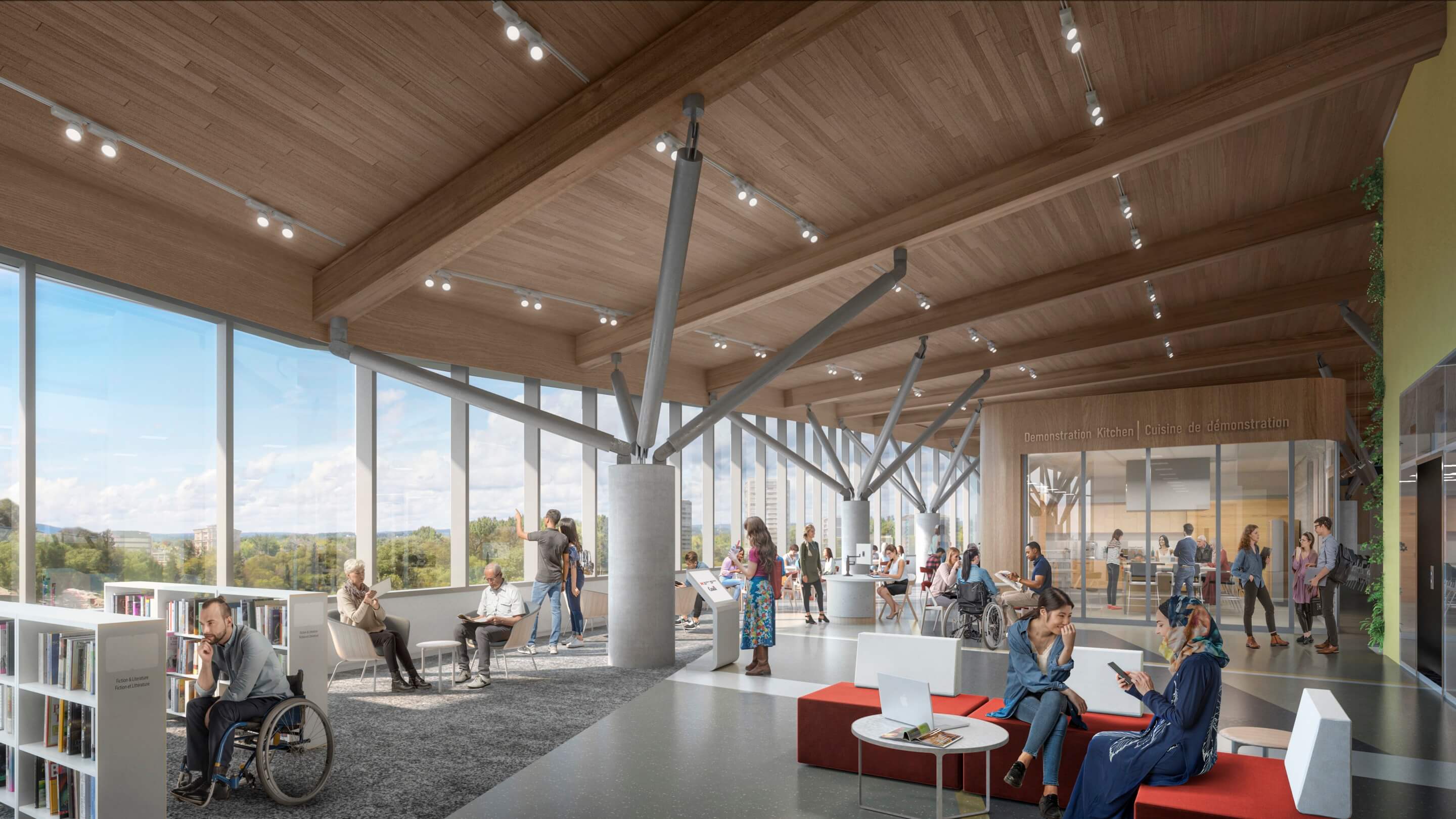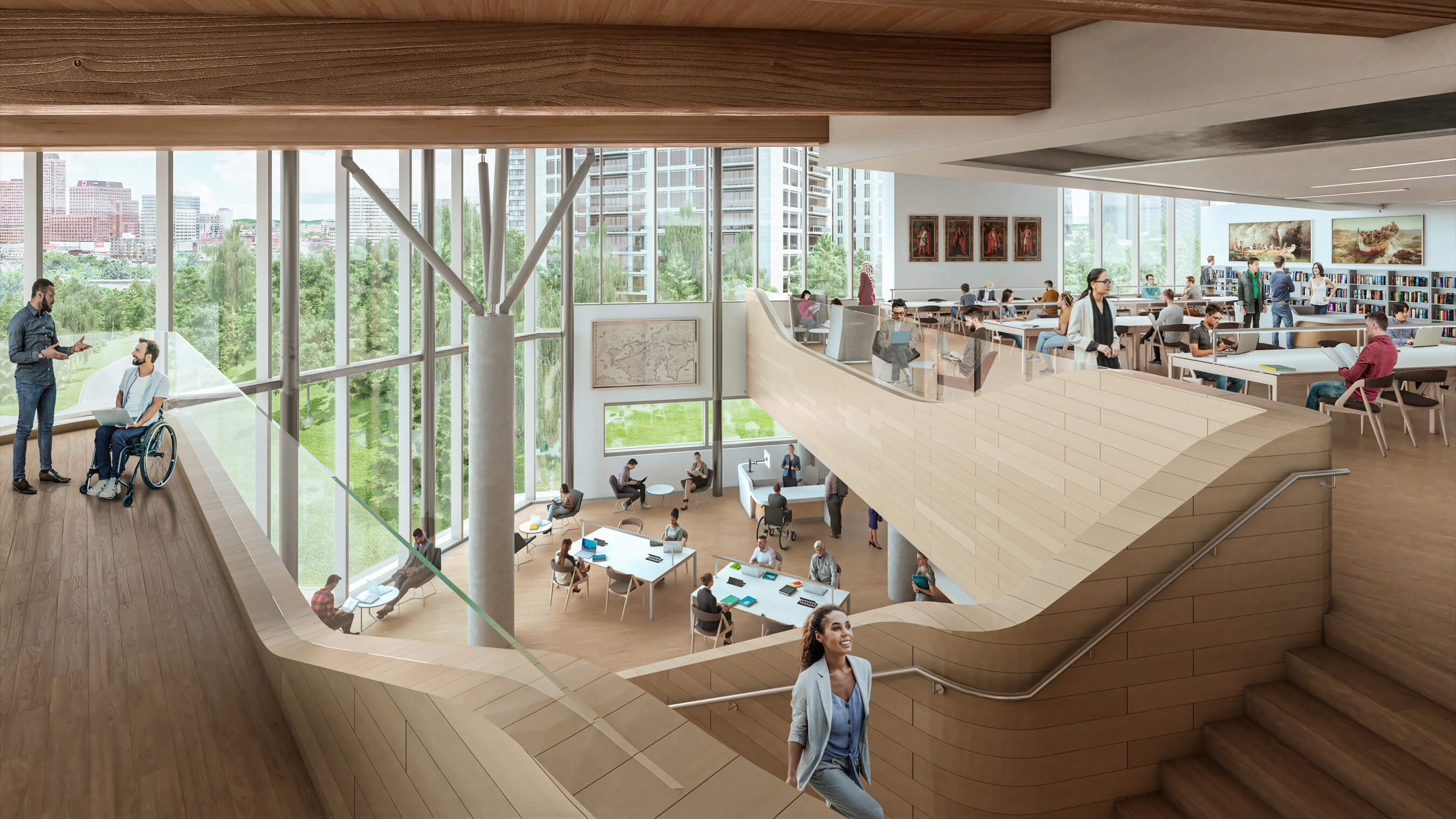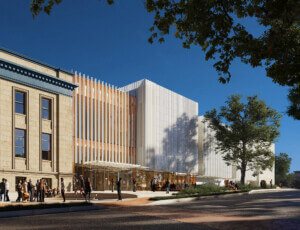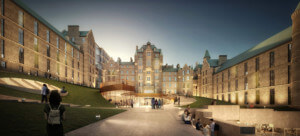A new architectural landmark is now officially set to rise near Parliament Hill in the Canadian capital city of Ottawa: the Ottawa Public Library and Library and Archives Canada (OPL-LAC) Joint Facility.
Designed by Toronto-headquartered Diamond Schmitt Architects in partnership with local firm and frequent collaborator KWC Architects, the 216,000-square-foot complex, which will pull double-duty as both the city’s flagship public library branch and Canada’s national library and archive, can claim two notable feats. When completed, it will serve as the new home to the fourth-largest library in the world in terms of cataloged items (World Atlas ranks LAC behind the Library of Congress, the British Library, and the New York Public Library) and the first new building completed in Ottawa’s Victorian architecture-dominated Federal precinct in almost three decades.
Currently, the central branch of the 33-location OPL system is housed within a boxy Brutalist structure in downtown Ottawa (replacing the city’s original 1906 Carnegie library at the same site) while the LAC is situated in a nine-story, granite-clad governmental building overlooking the Ottawa River designed by noted Toronto firm Mathers and Haldenby in the late 1960s. The OPL-LAC Joint Facility, described by Diamond Schmitt as a “five-story, multi-entrance, fully accessible cultural crossroad,” will mark the first time that these two venerable institutions—one municipal and the other federal—have shared a common space. Per earlier reports, the building will be split 60-40 between the OPL and Library and Archives Canada.

While both the OPL and LAC will be situated within dedicated areas within the net-zero carbon emissions-aiming building, a soaring public atrium/slash “town square” will serve as a bridge between the two and, as detailed by the firm, include a generous range of shared resources and amenities that benefit users of both institutions: cafes, digital production labs, genealogy center, meeting rooms, maker spaces, a kids-dedicated discovery center, and much more including public terraces and plazas. In total, the facility will be home to 425,000 works of art, 22 million books, and 3 million photographs.
“With the reveal of the design for this new world-class destination in our downtown, Ottawa is one step closer to achieving our vision to be the most liveable mid-sized city in North America,” said Ottawa Mayor Jim Watson in an earlier statement when the initial design was first made public in 2020. “I would like to thank everyone involved in this process for their input and for their commitment to helping us create a facility that is more than just a building—it will be a welcoming gathering space that will connect all of us together.”

Wrapped in glazing and topped with an undulating roof that references the movement of the nearby river, the building, as mentioned, is targeting Net Zero Carbon (and LEED Gold) certification and will feature a slew of sustainable features including a green roof, “advanced energy saving systems,” and enhanced natural daylighting provided by large skylights. The complex will also directly link to a nearby light-rail station and an active network of pedestrian and cycling paths. Used as both a design feature and structural element, natural materials such as wood and Algonquin limestone also feature heavily in the structure while paying homage to the rugged natural landscape of the riverfront site in the LeBreton Flats neighborhood, which was a historical meeting place for the Anishinābe (Algonquin) First Nations people.
As detailed by the firm, the Indigenous communities of the surrounding region, as well as Ottawa residents, were engaged throughout the design process and contributed feedback related to all aspects of the new facility.

Relatedly, Diamond Schmitt teamed with the City of Ottawa’s Public Art department to help envision an Indigenous art initiative to fund the commissioning of new, site-specific works and also bring existing works of Indigenous art to the new building. As noted by Diamond Schmitt, this arts programming initiative, carried out in collaboration with the Curator of Indigenous Public Art and Ottawa’s Public Art team, “is woven into the very infrastructure of the building—integrating artwork by local, regional, and national Indigenous artists throughout the interior and exterior of the new library and archives” and will including exterior pillars, external sculptures, and artwork for an Indigenous community space.
As reported by the CBC, the board of the OPC unanimously passed the final design of its portion of the project in early April; the plans were presented later that month to the National Capital Commission’s public board of directors. Also in April, Beverly McLauchlin, former Chief Justice of the Supreme Court of Canada, was announced as a spokesperson and honorary chair of the Ottawa Central Library fundraising campaign. The library hopes to raise $10-to-15 million to help pay for programming at its future central branch, which is scheduled to be completed in late 2024 and cost roughly $159 million ($192 million CAD).

As reported by the Ottawa Citizen earlier this week, construction bids opened on Monday following last month’s approval and release of the final design plans. Once a contractor is selected this summer, work is slated to kick off in the fall. Diamond Schmitt, which also led the lauded revamp of Polish-Canadian architect Fred Lebensold’s nearby (and once nearly window-less) National Arts Centre, and KWC Architects were originally selected to lead the design of the library in late 2018. Along with those two firms, the project team also includes Arup (sustainability planning, facades/building envelope consulting, and mechanical, electrical, plumbing, and fire suppression engineering), Fast + Epp (structural engineering), PFS (landscape architecture), and Morrison Hershfield (civil engineering).











